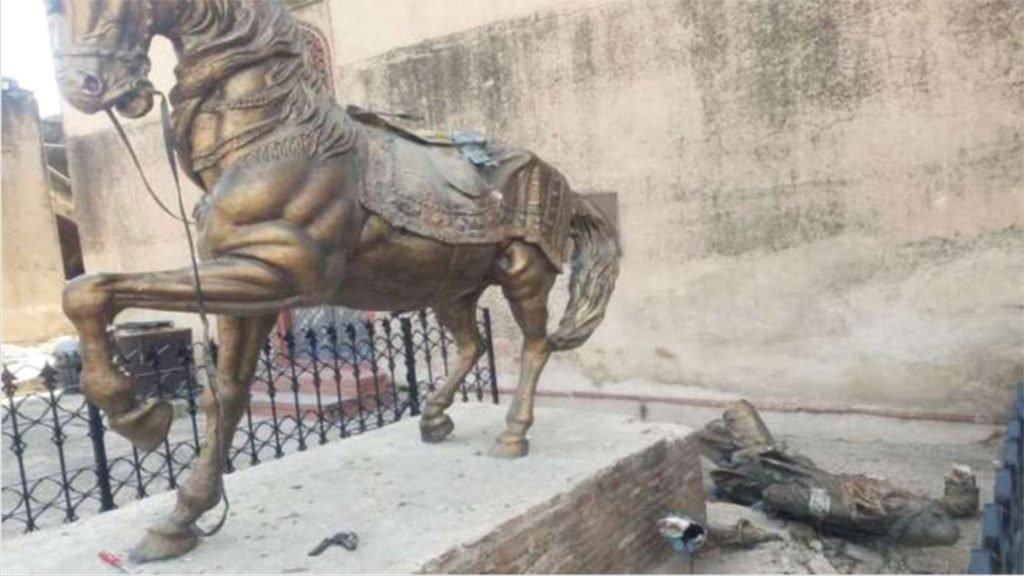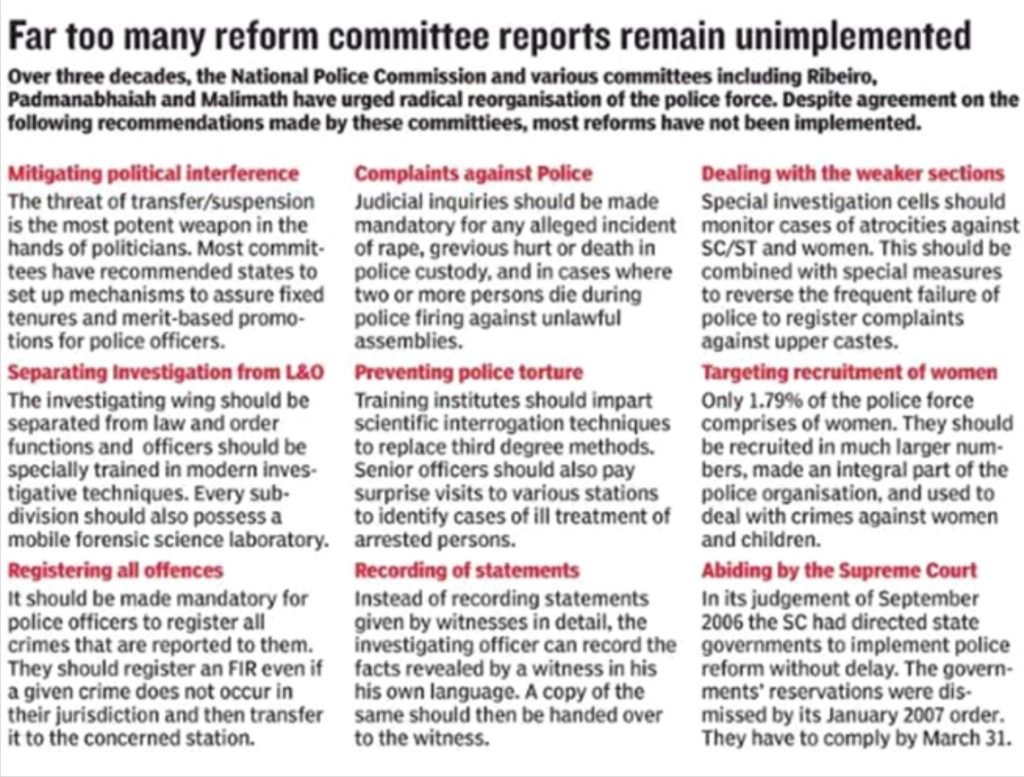Statue of Maharaja Ranjit Singh vandalised
Indian Express
GS 1: Indian History
Context:
- A nine-foot-tall bronze equestrian statue of Maharaja Ranjit Singh, the founder of the Sikh Empire, was vandalised in Lahore Fort.
Ranjit Singh and Lahore:
- Maharaja Ranjit Singh (1780-1839) seized Lahore in 1799 after he was invited to rule the city by its Hindu, Muslim, and Sikh elite.
- Lahore, once among the biggest and most developed of the cities of Punjab, was in a shambles at the time — the dying Mughal Empire was no longer able to extend it patronage and protection, it was battered by repeated assaults from bands of Afghan raiders, and weakened by infighting among some Sikh groups. Residents of Lahore complained of being forced to pay exorbitant taxes.
- Ranjit Singh brought peace and security to Lahore and revived its economic and cultural glory. He proclaimed himself Maharaja of the Punjab in 1801 and proceeded to rule with religious tolerance for communities other than Sikhs.
- He carried out repairs to the Lahore fort — which was built by Emperor Akbar at the site of an older mud-brick structure and was subsequently beautified and expanded by Shah Jahan and Aurangzeb — and built a wall around it, and used a part of the fort as his residential quarters.
Admired in Pakistan:
- As the founder of a mighty empire that sprawled over a large part of northwestern India, the Maharaja is identified by many with the identity of Punjab.
- Ranjit Singh advocated ‘secular’ values, and recalled his appointment of several Hindu and Muslim ministers.
- They recalled that he had handed over the famous Sunehri Masjid of Lahore, which had been converted into a Gurdwara by some Sikh militias, back to Muslims, and had funded its renovation.
The statue at the Fort
- A sustained campaign by social media activists, the Punjabi diaspora, especially Sikhs, and several small but vocal political groups culminated in the installation of Ranjit Singh’s bronze statue at Lahore Fort in June 2019 on the occasion of the Maharaja’s 180th death anniversary.
- The life-size statue was gifted to the Walled City of Lahore Authority (WCLA) by SK Foundation UK, an organisation based in the United Kingdom.
- Gurdwara Dera Sahib, built on the spot where the fifth Sikh guru Arjan Dev was martyred, and Ranjit Singh’s samadhi, located adjacent to the Lahore Fort, draw a large number of Sikh tourists from across the world.

Ratification of Kigali Amendment to the Montreal Protocol
Indian Express
PIB
GS 3: Environmental Pollution and Degradation
Context:
- Recently, the Cabinet approved Ratification of the Kigali Amendment to the Montreal Protocol on Substances that Deplete the Ozone Layer for phase down of Hydrofluorocarbons.
Montreal Protocol on Substances that Deplete the Ozone Layer:
- It is an international environmental treaty for protection of the Ozone Layer by phasing out the production and consumption of man-made chemicals referred to as ozone depleting substances (ODS).
- India became a Party to the Montreal Protocol on Substances that Deplete the Ozone Layer on 19 June 1992 and since then has ratified the amendments to the Montreal Protocol.
- India has successfully met the phase out targets of all the Ozone Depleting Substances as per the Montreal Protocol Schedule.
Kigali Amendment:
- Under the Kigali Amendment, Parties to the Montreal Protocol will phase down production and consumption of Hydrofluorocarbons, commonly known as HFCs.
- The Parties to the Montreal Protocol, reached agreement at their 28th Meeting of the Parties (MOP) held in October 2016 in Kigali, Rwanda to add HFCs to the list of controlled substances.
- The Parties approved a timeline for their gradual reduction by 80-85 per cent by the late 2040s.
- All amendments and adjustments of the Montreal Protocol, prior to the Kigali Amendment have universal support.
- India will complete its phase down of HFCs in 4 steps from 2032 onwards with cumulative reduction of 10% in 2032, 20% in 2037, 30% in 2042 and 80% in 2047.
- India will be ratifying the Kigali Amendment to the Montreal Protocol for phase down of Hydrofluorocarbons.
India : Implementation Strategy and Targets:
- National strategy for phase down of Hydrofluorocarbons as per the applicable phase down schedule for India will be developed after required consultation with all the industry stakeholders by 2023.
- Amendments to the existing legislation framework, the Ozone Depleting Substances (Regulation and Control) Rules to allow appropriate control of the production and consumption of Hydrofluorocarbons to ensure compliance with the Kigali Amendment will be done by mid-2024.
- India in 2016 committed to phase down HFCs in 4 steps from 2032 onwards with cumulative reduction of 10% in 2032, 20% in 2037, 30% in 2042 and 80% in 2047.

National Mission on Edible Oils – Oil Palm
PIB
GS 3: Indian Economy
Context:
- The Union Cabinet has given its approval to launch a new Mission on Oil palm to be known as the National Mission on Edible Oils – Oil Palm (NMEO-OP) as a new Centrally Sponsored Scheme with a special focus on the North east region and the Andaman and Nicobar Islands.
About:
- A financial outlay of Rs.11,040 crore has been made for the scheme, out of which Rs.8,844 crore is the Government of India share and Rs.2,196 crore is State share and this includes the viability gap funding also.
- Under this scheme, it is proposed to cover an additional area of 6.5 lakh hectare (ha.) for oil palm till the year 2025-26 and thereby reaching the target of 10 lakh hectares ultimately.
- The production of Crude Palm Oil (CPO) is expected to go upto 11.20 lakh tonnes by 2025-26 and upto 28 lakh tonnes by 2029-30.
- There are two major focus areas of the Scheme. For the first time, the Government of India will give a price assurance to the oil palm farmers for the Fresh Fruit Bunches (FFBs). This will be known as the Viability Price (VP).
- The second major focus of the scheme is to substantially increase the assistance of inputs/interventions. A substantial increase has been made for planting material for oil palm and this has increased from Rs 12,000 per ha to 29000 per ha.
Reforms in the Criminal Justice System
The Hindu
GS 2: Executive and Judiciary
Context:
- Recently, a group of experts under the National Human Rights Commission (NHRC) expressed serious concerns over the slow pace of reforms in the criminal justice system to ensure speedy justice.
NHRC Core Group Meeting:
- The delay in disposal of cases was leading to human rights violations of the under-trials and convicts.
- Despite the Supreme Court’s directions on police reforms, there had been hardly any changes on the ground.
- Special laws and fast-track courts could replace certain offences under the Indian Penal Code in order to reduce the piling up of cases at every police station.
- Not only were trials getting delayed, but court orders convicting a person also took years to implement.
- Delay in disposal of cases is leading to human rights violations of the under-trials and convicts.
- Digitisation of documents would help in speeding up investigations and trials.
- According to estimates, there were about 4.4 crore pending cases in the Supreme Court, High Courts, and district courts.
Need for Reforms:
- Colonial Flavour: Law has not changed much since the colonial era.
- Rising Pendency: Pendency of cases are rising exponentially with time and no additional mechanisms are being catered to (as per the demand).
- Dissociated Process: The process is disconnected from the people it was built for and nurtured over time. They might gradually lose confidence in the framework of government.
- Complexities: Cumbersome procedures are listed to initiate a case and till its disposal. Thus, people generally avoid getting into legal systems.
- Poor Coordination: Lack of coordination and system approach poses a big hurdle as there is no proper SOP defined and followed, making problems bigger only for citizens.
- Opaque System: Corruption is prevalent at all levels in the country. Lack of transparency in implementation of Law.
- Low Awareness: Lack of awareness amongst individuals comes as a hurdle specially for less literate people. They don’t know about their rights, let alone when they are violated.
Way Ahead:
- Fill the vacancies
- Speedy Justice
- Digitized Procedures
- Advanced Training in All Domains
- Infrastructure Advancement
- Handling Police Misconduct
- Abrogate Obsolete Laws
- Less Expensive Justice
- Raise Awareness
- Prison Reforms
- Implement the guidelines of Police Reforms laid down by the Supreme Court


